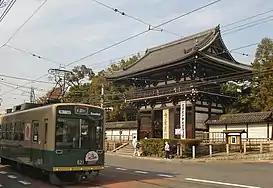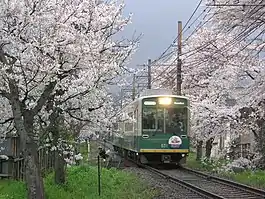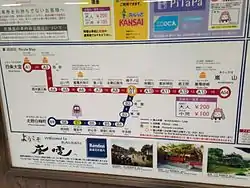Keifuku Electric Railroad
Keifuku Electric Railroad Co., Ltd. (京福電気鉄道株式会社, Keifuku Denki Tetsudō Kabushiki-gaisha) is a railroad company based in Kyoto Prefecture, Japan (but with offices in Fukui Prefecture) in operation since March 2, 1942.[1] It is a parent company of Keifuku Bus and Kyoto Bus, and an affiliated company of Keihan Electric Railway,[2] which owns 42.89% of the company stock. The company's stock is traded on the second section of the Tokyo Stock Exchange.
 | |
Native name | 京福電気鉄道株式会社 |
|---|---|
Romanized name | Keifuku Denki Tetsudō Kabushiki-gaisha |
| Type | Public (K.K.) |
| TYO: 9049 | |
| Industry | Private railroad |
| Predecessor | Kyoto Dento |
| Founded | 2 May 1942 in Kyoto, Japan |
| Headquarters | Kyoto , Japan |
Area served | Japan |
| Revenue | |
| Total assets | |
| Total equity | |
Number of employees | 885 (2015) |
| Parent | Keihan Electric Railway Co., Ltd. |
| Subsidiaries |
|
| Website | www |
Lines
This railway started service in 1910,[3] operated at that time by Arashiyama Electric Tram Railway (嵐山電車軌道, Arashiyama Densha Kidō). It was transferred to the Kyoto-based electric power generation company Kyoto Dento (京都電燈, Kyōto Dentō). Later it built the Kitano Line.[4]
Formerly the company operated several railway lines in Fukui Prefecture. Some of them are now operated by Echizen Railway.[5]
The Eizan Electric Railway also belonged to Keifuku until 1985.[6]
Randen
The Randen (嵐電, Randen) is a small network of interurban lines classified legally as tramways in Kyoto.
Arashiyama Line
| Arashiyama Line | |||
|---|---|---|---|
 A Randen tram car at Kōryūji Station, in front of Kōryū-ji Temple | |||
| Overview | |||
| Native name | 嵐山本線 | ||
| Line number | A | ||
| Termini | Shijō-Ōmiya Arashiyama | ||
| Stations | 13 | ||
| Color on map | Red | ||
| Website | randen | ||
| Service | |||
| Depot(s) | Sai | ||
| History | |||
| Opened | 25 March 1910 | ||
| Technical | |||
| Line length | 7.2 km (4.5 mi) | ||
| Track gauge | 1,435 mm (4 ft 8 1⁄2 in) standard gauge | ||
| Electrification | 600 V DC Overhead line | ||
| Operating speed | 40 km/h (25 mph) | ||
| |||
The Arashiyama Line (嵐山本線, Arashiyama Honsen) connects Kyoto's city center (Shijo-Omiya terminal) and scenic Arashiyama area in the western suburb.
| No. | Station | Japanese | Distance (km) | Transfers | Location |
|---|---|---|---|---|---|
| A1 | Shijō-Ōmiya | 四条大宮 | 0 | Shimogyo-ku, Kyoto | |
| A2 | Sai | 西院 | 1.4 | Nakagyo-ku, Kyoto | |
| A3 | Nishiōji-Sanjō | 西大路三条 | 2.0 | Ukyo-ku, Kyoto | |
| A4 | Yamanouchi | 山ノ内 | 2.8 | ||
| A5 | Randen-Tenjingawa | 嵐電天神川 | 3.7 | ||
| A6 | Kaikonoyashioro | 蚕ノ社 | 3.9 | ||
| A7 | Uzumasa-Kōryūji | 太秦広隆寺 | 4.4 | ||
| A8 | Katabiranotsuji | 帷子ノ辻 | 5.2 |
| |
| A9 | Arisugawa | 有栖川 | 5.7 | ||
| A10 | Kurumazaki-Jinja | 車折神社 | 6.2 | ||
| A11 | Rokuōin | 鹿王院 | 6.5 | ||
| A12 | Randen-Saga | 嵐電嵯峨 | 6.9 |
| |
| A13 | Arashiyama | 嵐山 | 7.2 |
Kitano Line
| Kitano Line | |||
|---|---|---|---|
 A Randen tram car under cherry blossoms | |||
| Overview | |||
| Native name | 北野線 | ||
| Line number | B | ||
| Termini | Kitano-Hakubaichō Katabiranotsuji | ||
| Stations | 9 | ||
| Color on map | Blue | ||
| Website | randen | ||
| Service | |||
| Depot(s) | Sai | ||
| History | |||
| Opened | 3 November 1925 | ||
| Technical | |||
| Line length | 3.8 km (2.4 mi) | ||
| Track gauge | 1,435 mm (4 ft 8 1⁄2 in) standard gauge | ||
| Electrification | Overhead line | ||
| Operating speed | 40 km/h (25 mph) | ||
| |||
The Kitano Line (北野線, Kitano Sen) is from Kitano Hakubaicho Station near Kitano Tenmangū to Katabiranotsuji Station in the midst of Arashiyama (Main) Line.
| No. | Station | Japanese | Distance (km) | Transfers | Location |
|---|---|---|---|---|---|
| B9 | Kitano-Hakubaichō | 北野白梅町 | 0 | Kita-ku, Kyoto | |
| B8 | Tōjiin Ritsumeikan University | 等持院・立命館大学衣笠キャンパス前 | 0.7 | ||
| B7 | Ryōanji | 龍安寺 | 0.9 | Ukyo-ku, Kyoto | |
| B6 | Myōshinji | 妙心寺 | 1.3 | ||
| B5 | Omuro-Ninnaji | 御室仁和寺 | 1.7 | ||
| B4 | Utano | 宇多野 | 2.1 | ||
| B3 | Narutaki | 鳴滝 | 2.6 | ||
| B2 | Tokiwa | 常磐 | 2.9 | ||
| B1 | Satsueisho-mae | 撮影所前 | 3.5 |
| |
| A8 | Katabiranotsuji | 帷子ノ辻 | 3.8 |
|
Eizan Cable
| Eizan Cable | |||||||||||||||||||||||||||||||||||||||||||||||||
|---|---|---|---|---|---|---|---|---|---|---|---|---|---|---|---|---|---|---|---|---|---|---|---|---|---|---|---|---|---|---|---|---|---|---|---|---|---|---|---|---|---|---|---|---|---|---|---|---|---|
| |||||||||||||||||||||||||||||||||||||||||||||||||
The Eizan Cable (叡山ケーブル, Eizan Kēburu), officially the Cable Line (鋼索線, Kōsaku-sen), is a funicular line in Sakyo-ku, Kyoto.
Eizan Ropeway
| Eizan Ropeway | |||||||||||||||||||||||||||||||
|---|---|---|---|---|---|---|---|---|---|---|---|---|---|---|---|---|---|---|---|---|---|---|---|---|---|---|---|---|---|---|---|
| |||||||||||||||||||||||||||||||
The Eizan Ropeway (叡山ロープウェイ, Eizan Rōpuwei) is an aerial tramway in Sakyo-ku, Kyoto. The line length is 0.5 km.
The cable and ropeway lines are for visitors to Mount Hiei on the northeastern edge of the city, together with Eizan Electric Railway's Eizan Main Line.
History
Arashiyama Line
The Arashiyama Tram opened the line in 1910, with 1,435 mm gauge and electrified at 600 V DC. The Kyoto Electric Light Company acquired the line in 1918, and double-tracked the track between 1925 and 1928. Keifuku acquired the line in 1942.[7]
Kitano Line
The Kyoto Electric Light Company opened the line between 1925 and 1926, and double-tracked the Tokiwa to Narutaki section in 1930. Plans to double-track the rest of the line were abandoned as a result of the economic depression. Keifuku acquired the line in 1942.[7]
Former connecting lines
- Arashiyama Station: A 3 km 1,435 mm gauge line electrified at 600 V DC and dual track except for the Kiyotaki tunnel operated to Kiyotaki between 1929 and 1944. It connected to a 2 km 1,067 mm gauge funicular which climbed 638 m to Atago Jinja on Mount Atago, Kosaku line which operated for the same period. Closed due to war time austerity measures, efforts to re-establish the incline in the 1950s were unsuccessful. (Atagosan Tetsudo)
Etymology
"Keifuku" is composed of two characters "京" and "福", the former denoting Kyoto and the latter Fukui. As the Kyoto Dento lines used to be in Fukui, the hydraulic source, and in Kyoto, the company took the name "Keifuku".
See also
References
This article incorporates material from the corresponding article in the Japanese Wikipedia
- 会社概要:京福電気鉄道 (in Japanese). Retrieved 22 March 2007.
- "FY2016 Financial Results Presentation - Keihan Electric Railway" (PDF). Retrieved 12 February 2017.
- JTB Timetable No. 975 (April 2007) (in Japanese). Tokyo: JTB Corporation. pp. 836, 839.
- Wakuda, Yasuo (和久田康雄) (1993). Shitetsushi Handobukku (私鉄史ハンドブック) (in Japanese). Tokyo: Denkisha Kenkyūkai (電気車研究会). p. 127. ISBN 978-4-88548-065-2.
- Kokudo Kōtsū Shō Tetsudō Kyoku (2003). Tetsudō Yōran (Heisei 15 Nendo) (in Japanese). Tokyo: Denkisha Kenkyūkai. ISBN 978-4-88548-103-1.
- 会社概要|叡山電車 [Company Profile - Eizan Electric Railway] (in Japanese). Retrieved 14 December 2015.
- 嵐電の歴史 [Randen History] (in Japanese). Retrieved 12 February 2017.
External links
| Wikimedia Commons has media related to Keifuku Electric Railroad. |
- Randen
- Keifuku Electric Railroad (in Japanese)
